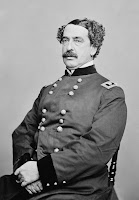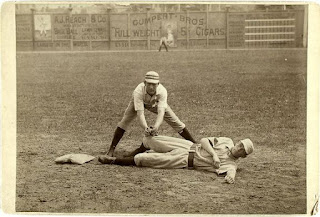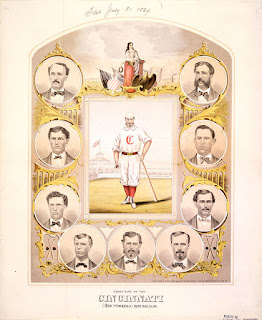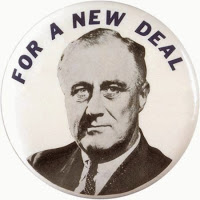Ask any one who invented baseball and if they have any answer at all, chances are they will mention Abner Doubleday and maybe Cooperstown, New York. After all, isn’t that the location of the National Baseball Hall of Fame and Museum? Yes.
For many years, Abner Doubleday was credited with having invented
The Game out of whole cloth, right there at Cooperstown in 1839. The rest is history.
Well, not exactly. In fact, not at all.
Abner Doubleday was a U. S. Army officer who later distinguished himself at Gettysburg in the Civil War. In 1839, however, he was still a cadet at West Point. There is no evidence of his ever visiting Cooperstown in any capacity. He certainly had no time or inclination to “invent” a game or even witness such an event. It is not known if he ever saw a baseball game; it was popularized and spread by the soldiers playing during the war, so it’s possible.
So how did this enduring myth become the popular notion about the origin of the game? And what’s up with Cooperstown?
Until around 1905, little thought was given to baseball’s origin. By then a former player, manager, club owner, and astute businessman had become a giant in the sporting goods business. Albert G. Spalding imagined, in a typically American way, that given the now popularity of baseball, it might be good for business if baseball could be shown to be a uniquely American game.
Spalding had for some time had a running conversation with an associate about the subject. The friend believed, correctly, that the game was not “invented” per se, but evolved from a number of stick-and-ball games such as Cricket and Rounders, and other games popular among boys in England.
 |
| Abner Doubleday |
Spalding decided to settle the controversy once and for all. He organized a commission to investigate baseball’s origin. His opinion was somewhat skewed by some vague information he had received in a letter from an old, old man, a native of Cooperstown, who reminisced about memories of a schoolmate, Doubleday, who the man claimed had written and drawn up the game one afternoon right there in Cooperstown.
This scenario fit perfectly into Spalding’s plan, and with his encouragement (not to mention coercion) to the commission, it was determined that “according to the best evidence obtainable to date, baseball was devised by Abner Doubleday at Cooperstown.” Said and done.
And then there is truth. Beginning well before the Civil War, baseball had been played in towns and cities, vacant lots, schoolyards, and streets all over America by boys, men, even girls according to their own local rules, which varied greatly.
Sometime around 1842, baseball began to get organized. A group of young men in Manhattan began to gather regularly to form loose-knit teams to play each other in one form of the game or another. Finally, in 1845, a young entrepreneur named Alexander Cartwright organized twenty-eight of these men to become the New York Knickerbockers Base Ball Club. The players came from many walks of life; their primary requirement was “to be at liberty after 3 o’clock in the afternoon”.
Cartwright and some of his associates had endeavored to codify the rules of baseball to bring consistency to the way the game was to be played. Those rules became the basis of baseball as we know it and is played today.
 |
| Image of a game in the 1880s - notice no glove! |
Now the game began to take hold. Scheduled games were now drawing sizable crowds. Even so, for many years in New York, baseball remained rigidly a gentleman’s game and strictly amateur.
But as the game spread it became decidedly less gentile and amateurism ultimately began to recede. In 1869, the first openly professional ball club took the field: the Cincinnati Red Stockings. With the realization that patrons would actually pay to see such a team the floodgates opened. American enterprise took charge. Baseball became our game…and our business.
Move ahead to 1936. The “100th Anniversary “ of baseball would be observed in three years.
In Cooperstown, a local resident thought an exhibition of a collection of baseball artifacts might generate some interest. After all, Cooperstown had been “officially” declared the home of the “invention” of baseball by Abner Doubleday in 1839.
The idea took hold. With significant backing from wealthy local resources, it was decided to establish a National Baseball Museum “for the purpose of collecting and preserving pictures and relics reflecting the development of the National Game from the time of its inception, through the ingenuity of Major General Abner Doubleday in 1839 to the present.”
 |
| The first nine - first team ever. |
Ford Frick, the president of the National League, expanded the idea: “create a permanent National Hall of Fame to be built and dedicated on the now recognized centennial of America’s Game.” A commission selected the first five members: Ty Cobb, Babe Ruth, Honus Wagner, Walter Johnson, and Christy Mathewson.
Now The National Pastime–the brand, if you will–was secured. Through depression, wartime, good times, and bad, baseball became inextricably woven into the fabric of American life. Even today, 177 years after Abner, it remains so.
Perhaps, at least on the professional level, baseball has been eclipsed by football and television and the spectacle of the Super Bowl. Even so, millions of children, from age six on, play baseball. Spectator attendance in sparkling state-of-the-art stadiums is at an all-time high. Revenues are in the billions of dollars. It’s organized, polished, and maybe overly supervised. But baseball is still a vital part of our lives. Part myth. Part legend.
And All-American.
References: Ken Burns Baseball-An Illustrated History
Baseball As America: Seeing ourselves through our National Game
Note: Post originally appeared in February 2016.
Cliff Gillock is a prominent figure in the marcom world, having advised epic brands, including Exxon, Shell, and Gulf Oil. He twice served as chair of the AAF-Houston President’s Council, won a national ADDY, and received an AAF-Houston Silver Medal in 2007. Gillock was also a curator for the AAF-Houston legacy exhibit. Learn more about Cliff and other contributors on the
Knights of the Round Table page.

 Follow on Instagram
Follow on Instagram






